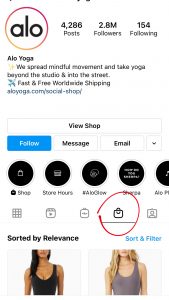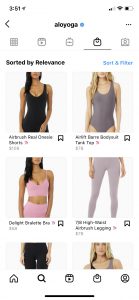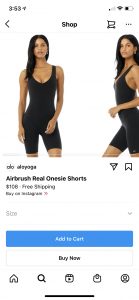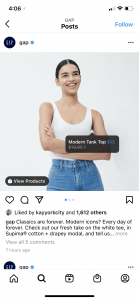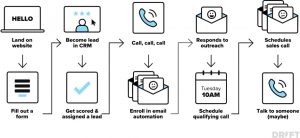Top digital trends for 2021 you should be paying attention to
Feeling overwhelmed trying to keep up with the latest digital trends?
We’ve kept our eyes on them so you don’t have to.
Keep reading for the top digital trends you should be paying attention to this year and how you can use them to grow your business.
Social Media as Purchase Platform
Do you sell products on social media? Listen up! Did you know you are more likely to lose sales when customers are asked to navigate away from the app? Lucky for you, social media platforms like Instagram are taking notice.
With the addition of in-app purchasing capabilities, you can now turn your social media channels into a primary shopping outlet. Instagram, for example, has added a Shop tab so users can buy products with just a few taps. The new feature was designed to create a quick and easy checkout process, ultimately resulting in a higher customer conversion rate.
Previously, business owners were forced to direct followers to the link in their account bio to make purchases on a separate website. Now, you can integrate your product catalog with your Instagram account, eliminating the need for users to navigate away from your page, and risking a lost sale.
This also gives you the chance to promote directly through main feed posts and Stories using Shop tags that link back to your product catalog.
Instagram is already the go-to resource for discovering new brands and products. Influencer marketing will only continue to explode in 2021 and is on track to become a 15 billion dollar industry by 2022.
Businesses have already reaped the rewards of the Shop tab since its unveiling last summer. Shari Lott, founder and CEO of the children’s clothing brand Spearmint Love even said,
“When we launched the feature [Instagram Shop], we experienced a 25 percent increase in traffic and an 8 percent increase in revenue attributable to shopping on Instagram.”
Let’s take a look at how the Shop feature works.
Once a business account uploads their product information (more on that in a minute), they’ll get access to the Shop tab. From there, Instagram users can make purchases in a matter of seconds without leaving the app.
Business owners can also advertise directly through Stories and feed posts, using Shop tags that lead viewers to their product catalog.
So, how do you set up the Shop feature for your business?
Once you’ve converted your Instagram profile to a business account, you’ll be prompted to link to your company’s Facebook page. From there, you can upload your product catalog from the e-commerce platform partner you probably already use on your website (like Shopify or BigCommerce) or enter products manually.
After entering your products and submitting your account for review in “Settings”, all you have to do is turn the “Shop” feature on, and you’re off to the races!
Check out this setup guide from Instagram for step-by-step instructions.
In-app shopping is taking the e-commerce world by storm this year. Taking advantage is as simple as adding a tag to the content you’re already posting!
Zero-click Search Results
If you’re here, you probably understand the importance of SEO when trying to get your content seen. In the past, obtaining the number one spot on Google has been the goal. However, with the introduction of featured snippets, position number zero is the new target
Zero-click search results, also known as featured snippets, refers to the first piece of information that appears at the top of your search engine after hitting enter.
Take this apple pie recipe for example:
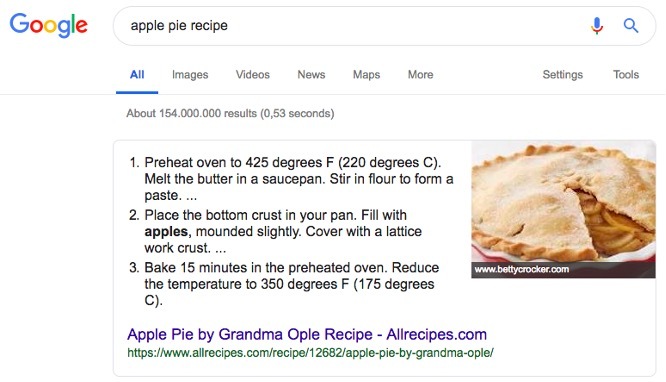
The recipe appears in a box at the top of the page without clicking on any links, hence the “zero-click search results” label.
Google explains the concept best.
“We display featured snippets when our systems determine this format will help people more easily discover what they’re seeking, both from the description about the page and when they click on the link to read the page itself. They’re especially helpful for those on mobile or searching by voice.”
Google is in tune with our desire for instant gratification and wants to provide answers as quickly and accurately as possible. It does so by producing the most popular, relevant, and credible source right off the bat, eliminating the need to comb through links to find what we’re looking for.
There are three main types of featured snippets, including:
- Paragraph – a block of text
- List – bullet points or numbered items, such as the apple pie recipe
- Table – single or multi-column tables
You’ll want to prioritize getting featured to increase page views, voice search results, and overall brand recognition.
To boost your chances of being featured, try putting yourself in your customers’ shoes. Tailor your content specifically to answer questions. What might you type in on Google to arrive at your article, website, or video?
Think about terms like:
- How does, do, to
- What is
- Why does
- Why do
It can be beneficial to make a few additions to your business’ website, such as a Q&A page, or a “How To” page to emphasize popular keyword searches. These types of pages will not only provide quick answers to commonly asked questions, but they’ll also increase the likelihood of Google picking them up to be used as a featured snippet.
SEO guru Neil Patel explains, “If your content doesn’t answer questions, it won’t get into the featured snippet. That’s all there is to it.”
Formatting is another essential step. Use descriptive headers (h1, h2, h3) and the optimal word count of 40-50 words for the best chance at being featured as a list.
Effortless Content Consumption
Now more than ever, we understand what we really have time for, and, more importantly, what we don’t. Because of this, easy-to-consume content will reign supreme in 2021. Media such as podcasts you can listen to on the go and email subscriptions that automatically drop into your inbox will increase in popularity.
With this top digital trend on the horizon, advertisers are already investing more into podcasts.

Aside from convenience, easily digestible content is a sign of respect from business owner to consumer. It shows you value your customers’ time, and want to enhance their daily lives, as opposed to drawing attention away from their responsibilities to focus on you.
Take social media stories for example.
They’re short, entertaining, and authentic. Stories are the very first thing you see when you open your social media accounts, and often get more attention than the main feed. There’s a reason they’ve gradually increased in viewership over the years. Stories don’t require you to scroll through every single post on your feed, accommodating our shortened attention spans.
This graph illustrates the growing popularity of Instagram stories’ daily users:
Podcasts and audiobooks are the best examples of easy-to-consume content.
They allow the listener to go about their daily tasks while tuning in.
You can wash dishes, do a load of laundry or take the dog for a walk all while learning something new. Instead of requiring twenty minutes of time you don’t have to read through an article or post, audio-based content consumption has the potential to increase your productivity. Multitasking actually does serve a purpose, if done correctly!
Consider investing more time and energy into creating content your followers can absorb easily.
Start a podcast where you share insights into your business. Interview professionals in your field to cast an even wider net, and share your conversation on YouTube. Commit to posting stories every day.
Your social media timeline is still important, and your website is paramount, but these easily-consumable content ideas are what will really grasp the attention of new customers, and ultimately lead to a lasting relationship.
Conversational Marketing
If you haven’t caught on yet, the theme of top digital trend in 2021 is convenience and timeliness.
Basically, we want answers and we want them now!
Conversational marketing is a great way to not only provide answers fast but also to personalize your customers’ experience.
Conversational marketing can be defined as a “one-to-one approach to marketing that companies use to shorten their sales cycle, learn about their customer and create a more human buying experience,” according to Drift.
This technique can be applied via an AI chatbot or a real-life person and is commonly used in the form of a messaging system on your website’s homepage.
Check out the traditional life-cycle of getting in touch with a company representative:
Kind of crazy, right?!
We don’t know about you, but the likelihood of jumping through that many hoops is … low to say the least.
Essentially, conversational marketing engages the customer in real-time without the necessity of calling a 1-800 number, filling out forms, or endlessly scouring the internet.
Let’s use our website for example!
You’ll notice a message icon in the bottom right-hand corner of our homepage.
When you click on it, it expands into a message box where you can easily chat with our team.
Although a homepage messaging system is one of the most common conversational marketing strategies, it’s not the only way to connect instantly with your clients.
Have you ever thought about how easy it would be to just text your customers directly?
Community.com is a conversation platform that enables personal messaging between industry leaders and their audience. The platform gives you a 10-digit phone number that you can promote across all platforms (hello social media content!), and use to text your followers directly!
Take a look at Community.com’s FAQ page for more details.
Audio-based Marketing
Audio content is huge right now, and it’s only getting bigger.
This might be our favorite top digital trend of 2021.
They’re convenient, personalized, and fit effortlessly into our lifestyles. Whether we’re at work, the gym, or walking the dog, there’s always some form of audio-based content that can keep us company. You can listen to hours’ worth of conversations and participate in them during a long road trip, or catch up on the news in a quick five minutes on your way out the door.
Audio is flexible and allows us to customize our experience.
Although they’ve been wildly popular over the past year, audiobooks and podcasts aren’t the only platforms to take advantage of when it comes to audio-based marketing.
The Clubhouse app is the new kid on the block.
Clubhouse is an audio-only social media platform that essentially allows users to drop in and jump out of virtual chatroom conversations at their leisure, with no obligation to contribute. Listeners can start in the main chatroom but can break off into smaller side discussions if they want.
There are chatroom topics for pretty much everything under the sun depending on who you follow, and some chats are even hosted by some of your favorite celebrities!
Exclusivity is a huge draw to the platform, as Clubhouse is invite-only at the moment. It’s still in its beta phase but is eventually expected to open its doors to the general public.
Another notable attraction is the user’s ability to connect with public figures in a more intimate setting than just any old social media platform like Instagram or Facebook.
With Clubhouse, listeners get the unique opportunity to participate in off-the-cuff discussions with the likes of Oprah, Drake, and Virgil Abloh. However, you don’t have to be famous to utilize this platform for your business!
Clubhouse is a great place to learn and grow within your field with the opportunity to connect with industry leaders. Eventually, you might think about hosting your own chatroom to increase brand awareness and connect with other like-minded individuals.
At the time of this article, Clubhouse is only available for iPhones and invite-only. You can still download the app and join the waitlist, but it’s important to start researching this medium regardless of registration so you can be as informed as possible when the floodgates open!
Check out this video for a guided tour of Clubhouse to get started!
Personalization
Catering your customers’ experience to their specific needs is everything this year.
You’re probably familiar with how annoying it is to get mass emails. They have nothing to do with you, other than the fact that you bought a sweater from the brand nearly five years ago as a Christmas gift for your brother. (Not that I have any specific personal experience…)
Email blasts can be difficult to manage, and most times just inundate our already overflowing inboxes. They risk tainting your business.
However, email campaigns are a double-edged sword. When done correctly, you can reach clients in a thoughtful, relevant, and personal way.
According to an Epsilon survey of 1,000 consumers ages 18-64:
- 63% are annoyed by generic email blasts
- 80% (!!!) say they’re more likely to do business with a brand if it offers a customized experience
So, how can you personalize your customer experience? Start small, and work your way up.
Getting to know your audience is the perfect place to start. After all, if you don’t know your customers, are you truly marketing effectively?
Take advantage of surveys and questionnaires through email, social media, and your website. Asking questions will ensure the media you’re producing is solving a problem, and ultimately helping your clients to the best of your ability!
Interact with your social media followers on a regular basis.
Another simple, yet impactful step is putting a face to a brand. People want to see the human side of your business.
Turn the camera around on social media. Consider adding profile pictures and author descriptions underneath articles on your website.
These efforts provide your customers with a sense of security, connection, and relatability.
Email marketing personalization surrounding birthdays and anniversaries is 26% more likely to be opened than any other type of mail. Throw in a free gift or voucher to show your appreciation for your customer, and simultaneously increase the chances of future engagement!
Let’s take a look at a few shining examples of personalized marketing.
Starbucks
Starbucks’ mobile app turns your daily coffee run into a game!
Aside from retaining your personal information such as location and order history to make checkout a breeze, they also use a star balance rewards system.
This encourages customers to continue purchasing to achieve the next star status and earn free beverages, food, and merchandise.
Starbucks’ revenue soared to $2.56 billion after the system was implemented.
Coca-Cola
Coca-Cola capitalized on personalized marketing with their “Share-a-Coke” campaign that’s still in place today.
They were able to create an emotional connection with the younger generation. Who, at the time, were consuming less of their product by putting popular names on their cans.
Netflix
Netflix has personalization down pat with their recommendation feature.
Beyond curating movie and TV suggestions based on your viewing history, the streaming service customizes content covers, highlighting actors and actresses you’re familiar with.
Want more help tackling these top digital trends? Relly’s membership program offers ongoing support led by industry experts. Included in your membership…
- Access to on-demand marketing courses
- Social prompts and caption templates
- Access to dedicated marketing support agents to answer your questions
- Customizable graphics for social, email, ads, presentations…
- and more…
Featured Posts
5 Small Business Marketing Ideas for 2023
Check out these 5 Marketing Ideas to help keep grow your business and keep your audience engaged.
Read More
Common Marketing Mistakes Small Businesses Make.
Be better prepared so you can avoid making these mistakes in your business.
Read More
Marketing Tools for Small Businesses
We help you break down the most important tools to help you run your business.
Read More
